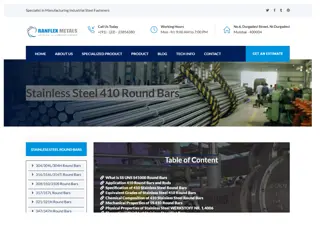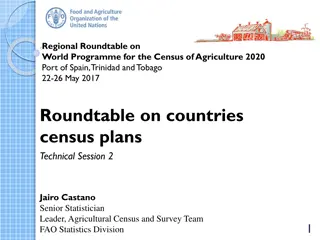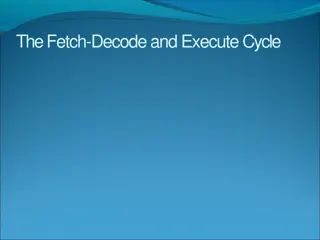
Strategies for Efficiently Completing Fundraising Rounds
Learn how to optimize your fundraising efforts with strategies emphasizing speed, focus, and flexibility. Discover the key steps involved in executing a successful funding round, from refining your pitch to managing the process effectively. Gain insights on treating fundraising like a campaign, leveraging various funding sources, and practical tips for getting started in the fundraising journey.
Download Presentation

Please find below an Image/Link to download the presentation.
The content on the website is provided AS IS for your information and personal use only. It may not be sold, licensed, or shared on other websites without obtaining consent from the author. If you encounter any issues during the download, it is possible that the publisher has removed the file from their server.
You are allowed to download the files provided on this website for personal or commercial use, subject to the condition that they are used lawfully. All files are the property of their respective owners.
The content on the website is provided AS IS for your information and personal use only. It may not be sold, licensed, or shared on other websites without obtaining consent from the author.
E N D
Presentation Transcript
Executing a Round Only losing weight is harder than raising money (this presentation is available online)
Objective: complete a round as quickly as possible Speed is more important than anything else: because funding is a distraction and you need to continue to execute things happen: the faster you move the less things will happen deals need momentum, if they stall they rarely complete To get it done fast you have to concentrate on it, dedicate time and resources, and run a systematic campaign You have to be flexible: on valuation on the size on the terms
The Process Refine Pitch Prepare Answers Re-pitch No Complete round B Pitch Find VC s List Follows round A List New Leads Leads round: Term Sheet When you have a Term Sheet you are trying to convert B List into A List This process is continuous until the round is complete, target 3-5 pitches per day
Managing a Round Treat it like a Campaign (c.f. development project or product launch) VC s will expect the CEO to run it make yourself accountable to your team all senior team must be prepared to help review progress multiple times per week It is NOT a part-time job: the CEO must make it their TOP priority back-fill other responsibilities if you don t make it your #1 priority it won t happen It s simple: if you don t raise, you die.
Sources See Julien s list for the suspects All sources will be part of your campaign A few comments: Corporates - we don t favour this Corporate VC s - yes, if they are really set up like a VC Grants - can be dangerous for development these are good for operational funding they are dangerous reliance on free money: you forget how to pitch your business you can easily start to bet on future wins if you get one
Getting started Trawl the FRC VC contact list Get your principal to make intros - personal introductions are most effective use LinkedIn to try to find contacts in common Trawl online for VC s regional better than international look at sectors look at the deals they ve done (size/sector/geography) If you go for grants - trawl local and EU sources Make your campaign spreadsheets - you will wake up and go to bed with them Send your emails/contact directly if they have portals
Campaign Spreadsheets: progress and feedback Topic Question Answer Market What happens if Google copies your idea? We differentiate on the basis of privacy. Tech What platform do you use? Full stack thing with exciting stuff running on AWS. There s nothing special or clever here - but you need tools to manage the process (spreadsheet available)
Pitching You should get to pitching 3-5 pitches per day, expect to do it 100+ times during the process If the VC asks for a 3 minute, 22.5 second pitch, give them a 3 minute, 22.5 second pitch (+/- 1 second) - do what you re asked to do Be intelligent: know the VC before you pitch look them up, check their portfolio It will change during the process: listen to the feedback - what people like/don t like about the story don t flip/flop, but if there is consistent feedback then use it Record every question and answer every question: and prepare a better answer for next time Do not lie yes, you can do some marketing , but if there is a fact you have to state it Know your numbers inside out Ask at the end about their process and when you can expect feedback
Weekly reviews Make sure the funnel of VC s is still looking good send out more requests, LinkedIn etc. ask for help from Principal at FRC Be honest with the Campaign Spreadsheet mark the maybe s, A/B listers honestly if it looks bad then act on it, don t try to make it better Look internally: is it working? is round to big/small, is valuation ask an issue? what are reasons for rejection Keep going: Frog theory - keep kissing
Feedback: what it (usually) means Response What it Means What to do No No Say thanks and offer to stay in touch. This is the only honest answer that isn t cash in the bank. I ll get back to you Interesting Call back two times max, then give up. No. This is the long yes. Outside our range or focus, valuation too high Not now, but keep us posted. Don t bother - this means no. Let s have another call Interested: wants to get someone else/more senior involved Schedule it asap. Ask what areas they would like to cover and prepare to deal with these in detail. Going to committee Good news. Ask what they need, and then provide it. Term Sheet Very good news This is almost a commitment. Unless it is egregious or you have a better one, accept it.
When you get feedback: try to get value from it Valuation too high Response: Make me an offer - even if it is low-ball, it does no harm to have an offer Round too big This indicates that they think the valuation is high to minimise dilution Have a back-up (lower) raise plan available to send would you consider a bridge round Worried about traction Response: would you consider investment in stages? Cannot see the USP you should be prepared for this you need to find something that captures the imagination of the VC If in doubt ask your Principal Always ask for a lead (unless it s clearly inappropriate) Always ask for reasons for rejection - there are good and bad ways to ask
How to complete a round: run A-list and B-list Eventually, you will get a nibble, or a bite Try to find one of them to lead they will set the terms of the round they will set the conditions for completion put them on the A-list All the others will either fall away or you can put them on the B-list You will complete the round by fulfilling the requirements of the A-list with the commitments of the B-list. The key thing is to get a Term Sheet out of someone ..BEFORE YOU LOSE THE INTEREST OF THE B-LIST
The Term Sheet It s usually full of stuff that the investor wants for downside protection: this is secondary Amount, valuation and involvement are the key terms Beware of more than money , it is usually a way to get more equity look out for equity for services - ask your Principal You may get a chance to negotiate a Term Sheet, but probably not ...
What to do when you have a Term Sheet If in doubt - ASK YOUR PRINCIPAL AT FRC Unless it s egregious accept it your obligation with a Term Sheet is good faith you can get out of it, but you need a better reason than I got a better offer if it s for the whole round - well done! If it s for part of the round: still accept it schedule to talk to your lead investor each week start contacting your B-list to complete the round Start preparing for due diligence ask your lead investor what they want to see ask you Principal at FRC
Completing the round - when your Term Sheet falls short of the total Ask If in doubt - ASK YOUR PRINCIPAL AT FRC Go to anyone else on your A-List get the Term Sheet issuer to give you leads to go after tell them you have a term sheet and share it with them (you need permission for this) Go to your B-list: that is what they are there for! Keep your Lead Investor appraised at all times others will ask to speak to the Lead Investor - facilitate this immediately If the round looks over-subscribed, don t be greedy
Closing the round: due diligence Be ready with a data room even before you get a term sheet audited financials if you have them any prospectuses monthly performance reports Legal documents incorporation documents structure charts if you have a complex holding structure existing shareholders agreements, CLA s etc. Product documentation demos code/structures Ask the Lead Investor Never be tempted to create a false document
Closing the round: legals Lead Investor usually handles the legals if not, then you will need to: follow the Term Sheet completely Do not choke on the documentation it will look horrible don t let your lawyer take control of the process - use them for advice, but you run the show - we do not recommend getting a lawyer to go back with a marked up draft agreement remember the investor is giving you money with very little control over what you do, they are only seeking protection - the balance of risk is actually heavily weighted in your favour if you want to go back with issues: articulate them in the context of reality not legality Ask for a signing timeline and do everything you need to do - never be the hold-up
Common Mistakes Stopping new leads when you have an offer Do not stop until you have agreed a term sheet Even then, if the round is not complete keep running your B list Getting hung up on valuation Unless you have competing term sheets you are not strong enough to negotiate valuation Having the highest valuation and being unfunded is useless If someone is offering funding: take it! Getting hung up on the legals Most terms are standard - accept them Accept that taking other people s money comes at a price Don t do a deal that you cannot work with It is rare, but sometimes you have to say no: usually about control. Be careful with strategic investors
FRC Involvement We will indicate leading or following a round at the start if we follow, it s because we want others to set the price, sometimes we will indicate an amount/pro-rata - put us on the B-List. if we do not follow, it usually because we have limits Get the early introductions from FRC2 we may put on a demo day, and we will always make a warm introduction if we can Keep us posted on progress every couple of weeks, check in with your Principal: developments, questions, etc We will help with Term Sheets and Legals we ve done loads of deals, use us for free advice You will need our consent to a round, so make sure we are in the loop in general we are 100% supportive of getting you financed We will have given you pitch training, we also have sample questions Abuse your Principal!






















